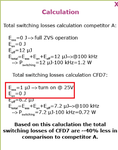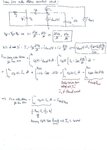CataM
Advanced Member level 4

- Joined
- Dec 23, 2015
- Messages
- 1,275
- Helped
- 314
- Reputation
- 628
- Reaction score
- 312
- Trophy points
- 83
- Location
- Madrid, Spain
- Activity points
- 8,409
Hello everyone,
I saw this Infineon advertising product video:
https://www.infineon.com/cms/media/eLearning/PMM/eLearning_600VCoolMOSCFD7/
In the section "Technical features and benefits" --> "Improved switching losses Eoss II", at the end of the video they show how they calculate switching losses. They add to the "Eon" energy (based on drain-source voltage overlap with drain current) the "Eoss" one. Infineon and some other well known manufacturers do this, while others stop at the overlap between drain voltage and drain current in order to estimate switching loss.

P.S: They say "Eon" is negligible for 25V, so they account only for "Eoss" in the CFD7 example.
I believe adding "Eoss" to the whole "Eswitching" is mistaken, but since so many others include it, makes me back up..
The explanation why Eoss should not be included in the overall switching loss is this (please tell me if I am mistaken):
Notation: "Id" is the current flowing into the drain of the MOSFET and NOT into the channel. In other words, "Id"=channel current + current into the parasitic capacitors i.e. the current one can measure.
-During turn ON, the Coss capacitor discharges into the channel of the transistor, making the current into the channel of the transistor be higher than the one we are measuring, i.e., channel current=Id (measured with scope) + additional current from the Coss discharge. Hence, using the Vds*Id|during switch ON time makes us underestimate the turn ON switching loss because the "Id" current we are measuring is less than the actual current flowing into the channel of the transistor. The actual switching loss during switch ON needs to have the loss of the Coss.
-During turn OFF, throughout the drain-source voltage switching instance, when we assume the drain current stays constant, the Coss capacitor is being charged with current from the channel of the transistor, so, in the channel of the transistor actually flows less current than the one we are assuming (i.e. measuring at the drain terminal). So, using the Vds*Id|during switch OFF time makes an overestimation of the turn OFF switching loss.
-Combining turn ON loss (underestimation) and turn OFF (overestimation), due to the energy conservation i.e. the energy Coss bleeds out, the same must be replaced, Eoss is nulled into the whole switching process.
In other words, I am claiming this:
turn ON loss --> Vds*Id|during switch ON time + Eoss
turn OFF loss --> Vds*Id|during switch OFF time - Eoss
Overall switching loss --> Vds*Id|during switch ON time + Vds*Id|during switch OFF time
Am I overlooking something ?
Any comment is appreciated !
I saw this Infineon advertising product video:
https://www.infineon.com/cms/media/eLearning/PMM/eLearning_600VCoolMOSCFD7/
In the section "Technical features and benefits" --> "Improved switching losses Eoss II", at the end of the video they show how they calculate switching losses. They add to the "Eon" energy (based on drain-source voltage overlap with drain current) the "Eoss" one. Infineon and some other well known manufacturers do this, while others stop at the overlap between drain voltage and drain current in order to estimate switching loss.

P.S: They say "Eon" is negligible for 25V, so they account only for "Eoss" in the CFD7 example.
I believe adding "Eoss" to the whole "Eswitching" is mistaken, but since so many others include it, makes me back up..
The explanation why Eoss should not be included in the overall switching loss is this (please tell me if I am mistaken):
Notation: "Id" is the current flowing into the drain of the MOSFET and NOT into the channel. In other words, "Id"=channel current + current into the parasitic capacitors i.e. the current one can measure.
-During turn ON, the Coss capacitor discharges into the channel of the transistor, making the current into the channel of the transistor be higher than the one we are measuring, i.e., channel current=Id (measured with scope) + additional current from the Coss discharge. Hence, using the Vds*Id|during switch ON time makes us underestimate the turn ON switching loss because the "Id" current we are measuring is less than the actual current flowing into the channel of the transistor. The actual switching loss during switch ON needs to have the loss of the Coss.
-During turn OFF, throughout the drain-source voltage switching instance, when we assume the drain current stays constant, the Coss capacitor is being charged with current from the channel of the transistor, so, in the channel of the transistor actually flows less current than the one we are assuming (i.e. measuring at the drain terminal). So, using the Vds*Id|during switch OFF time makes an overestimation of the turn OFF switching loss.
-Combining turn ON loss (underestimation) and turn OFF (overestimation), due to the energy conservation i.e. the energy Coss bleeds out, the same must be replaced, Eoss is nulled into the whole switching process.
In other words, I am claiming this:
turn ON loss --> Vds*Id|during switch ON time + Eoss
turn OFF loss --> Vds*Id|during switch OFF time - Eoss
Overall switching loss --> Vds*Id|during switch ON time + Vds*Id|during switch OFF time
Am I overlooking something ?
Any comment is appreciated !




